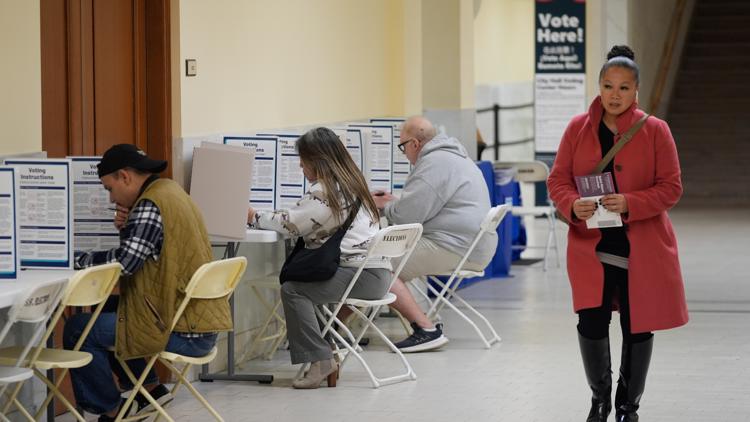CALIFORNIA, USA — Under the blistering Sacramento sun outside the Capitol last week, advocates for Black, Latino and Asian communities spoke about the importance of diversifying California’s voters.
That’s why they’re part of a coalition of dozens of organizations backing a bill to automatically register people to vote at the Department of Motor Vehicles. “We must ensure that every eligible citizen … can exercise our rights to vote with as few barriers as possible,” said Sydney Fang, policy director at the advocacy group AAPI-Force.
The bill aims to capture the state’s 4.7 million residents who are unregistered but eligible to vote — and who are predominantly Black, Latino, Asian or younger.
“That is 4.7 million Californians whose voices are not being heard,” Sen. Monique Limón, the bill’s author, said at the small rally at the Capitol.
“It is unacceptable that working-class communities of color continue to be systematically left out of access to political power,” the Santa Barbara Democrat added in a statement after the rally. “We must take the necessary steps to ensure that California’s diverse population becomes a diverse electorate that truly represents the power of our state.”
In the 2022 general election, close to 27 million people were eligible to vote in California. About 22 million were registered, and about half voted.
The proposal is the latest effort to try to expand California’s “motor voter law,” which directed the DMV beginning in 2018 to register people to vote when they apply for a license or ID or change their address — if they indicate they’re eligible and unless they opt out. The bill proposes registering everyone who is eligible without prompting, and informing them later with a postcard.
But the bill, revived from last year, has drawn concern from groups that support expanding voter access, including the League of Women Voters of California, the American Civil Liberties Union of Northern California and NALEO, a nonprofit group focused on Latino civic engagement.
They say registering to vote should be voluntary — and they don’t see the bill as an effective way to increase voter diversity.
“This is a solution looking for a problem,” said Rosalind Gold, chief public policy officer for NALEO Educational Fund. “Right now, California should not be spending its scarce resources on something that is not going to have any kind of negligible impact on strengthening our democracy, and in fact, could have some harmful consequences.”
The proposal is scheduled to be heard in the Assembly’s elections committee on June 26.
The bill would take effect for the 2026 election for governor and other statewide offices — or when the Secretary of State certifies a system to make sure the DMV can sort out who isn’t eligible to register, including those who are undocumented but get special licenses.
The Secretary of State, despite commenting on previous election-related legislation, declined comment on the bill to CalMatters.
Eric McGhee, senior fellow at the Public Policy Institute of California, said lawmakers should consider whether their goals are to get people’s names into the system and worry later about turning them into regular voters, or whether they want to focus on registering those who are most ready to vote.
“It doesn’t do anything, by itself, to turn them into voters and make sure that they vote,” he said. “It just removes registration as a hurdle.”
How past registration changes fared
Twenty-five states have a form of “automatic” voter registration at state agencies. California is one of 14 states with a system that prompts you to choose, according to the National Conference of State Legislatures, while another 11 have the kind of system Limón is proposing.
Since California’s “motor voter” law rolled out, registration among the state’s eligible voters has gone up from 75% to 83% in January 2024. Researchers attribute more than half of that increase to the new system.
But making voting easier doesn’t necessarily lead to higher voter turnout, according to Charles Stewart, director of the MIT Election Data and Science Lab.
And California’s current system didn’t boost registration among all the underrepresented groups the current bill aims to help, according to a March analysis by the Public Policy Institute of California. While new registrations increased among Asian voters and those under 35, it didn’t for Latino and Black Californians.
The system has been effective at allowing existing voters to update their addresses rather than adding new voters, according to the report — though that wasn’t the goal of easier registration.
“While all groups have seen gains, registration policy changes have not always improved equity in the way that might have been expected,” the report concluded. “Given that Latino and Black residents and young people participate in elections at lower rates, gains in registration needed to be larger than those of older or white Californians in order to correct these past imbalances.”
But Neal Ubriani, policy and research director for the Institute for Responsive Government, argues that automatically registering people will increase political participation, building on California mailing ballots to all registered voters. Limon’s office confirmed the bill was based on research from the institute, which has pushed for what it calls the “SAVR” bill (Secure Automatic Voter Registration) in 11 other states.
Ubriani is also a member of California’s Motor Voter Task Force, though it has not discussed the bill or automatic voter registration.
“If somebody’s not registered to vote, they’re kind of invisible to grassroots groups, to campaigns, to election officials,” he said. “They can’t reach out to them … They can’t teach them about the issues that are on the ballot. They can’t give them the kind of outreach that might get them excited about maybe a local candidate, or a state Senate race, or even president.”
But the ACLU says people should have the right to decide whether to register, or not.
While the organization is committed to reducing barriers to voting, specifically for underrepresented groups, “we’re also concerned about other issues like privacy, and First Amendment rights, and associational rights — and so we have to consider all of those together,” said Brittany Stonesifer, an attorney with the ACLU of Northern California’s Democracy & Civic Engagement Program.
Stonesifer also said it’s important for people to actively engage in the voting process — “to make meaningful choices that represent their decisions on the ballot.”
The groups who oppose the bill also say automatic registration could make it more difficult for voters if they want to change their political party, especially to vote in presidential primaries, or if they want voting materials in a language different from what they use at the DMV.
Ubriani took issue with the idea that the system deprives people of a choice.
“This process is just turning voting as much as possible into a one-step process to say, we know you’re eligible, we’ve made voter registration as easy as possible for you, if you want to participate, that’s up to you,” he said.
Will ineligible voters get registered?
Both supporters and opponents of the bill say that it’s extremely rare for ineligible people to get on the voter list.
Still, state government’s track record on technology is spotty at best: When California’s current system started at DMV offices in 2018, about 23,000 people were registered with errors — including 1,600 people who hadn’t intended to register, including some non-citizens. Others had incorrect information added to their registrations, such as party preferences. The registrations were canceled by the Secretary of State, the Associated Press reported.
It’s a crime to register to vote, or to vote, when you’re not eligible, such as not having citizenship or not having voting rights restored after a felony conviction. Proponents of the bill say that shifting the burden of erroneous registrations to the state would protect people who might accidentally register under the current system and thus unintentionally break the law.
But opponents say there isn’t enough evidence of that problem. And, according to Stonesifer, the bill could put noncitizens at risk of being deported, losing their legal status or being denied citizenship.
Under current law, if someone registers and they’re not eligible, there are some legal protections in place.
But if someone gets a ballot in the mail because they were registered automatically and sends it back, that person will have voted illegally, she said.
And while the motor voter system had a bumpy roll-out, it now works effectively, the ACLU says.
The DMV is already overhauling its software system, a project that is scheduled to finish in 2027. That, along with the lack of clear roadmap on how the DMV would sort out those who are eligible, could set the agency up for failure if the state adopted automatic registration, Stonesifer said.
“It creates a much more complicated system than we currently have and puts the responsibility in the hands of the DMV, which doesn’t have the best track record for getting that right,” she said.
Limón, however, said the current bill learns from the 2018 rollout at the DMV. “We know where the technology and where the challenges were,” she said.
How much would automatic registration cost?
It’s unclear how much the bill will cost the state or counties, but Limón acknowledges that with the projected state budget deficit, any bill with additional cost is going to have an uphill battle.
The bill’s opponents say there are more effective ways to increase political participation among underrepresented communities, such as permanent funding into voter outreach.
Gold said a worthwhile investment to engage more Latino voters would be to fund community-based organizations as “trusted messengers” who can explain how to vote, what the issues are and why they matter.
NALEO supports expanding the current program to allow people to register to vote when they apply for benefit programs such as Covered California or CalWORKS, which might better target people from underrepresented communities. Seven states have passed laws since 2019 to allow registration at Medicaid offices, but they’re on hold as officials await guidance from the Biden administration, which has expressed concerns about confidentiality, NPR reports.
Limón said that while some have suggested waiting before making more changes to voter registration, others — including labor organizer Dolores Huerta, who spoke at last week’s rally — have been trying to expand voter rights for decades and say the time to act is now.
“You’ve got to begin this work, and you’ve got to do it so that eventually we get to a place where everybody that is eligible has that opportunity,” Limón said.
This article was originally published by CalMatters.
WATCH ALSO:





















